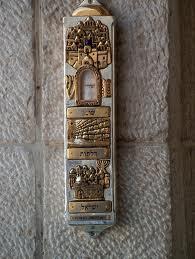A mezuzah is a piece of parchment (often contained in a decorative case) inscribed with specified Hebrew verses from the Torah (Deuteronomy 6:4-9 and 11:13-21). These verses comprise the Jewish prayer "Shema Yisrael", beginning with the phrase: "Hear, O Israel, the LORD our God, the LORD is One"
A mezuzah is affixed to the doorframe in Jewish homes to fulfill the mitzvah (Biblical commandment) to inscribe the words of the Shema "on the doorposts of your house" (Deuteronomy 6:9). Some interpret Jewish law to require a mezuzah on every doorway in the home apart from bathrooms, and closets too small to qualify as rooms; others view it as necessary only to place one in the front doorway. The parchment is prepared by a qualified scribe (a "sofer stam") who has undergone many years of meticulous training, and the verses are written in black indelible ink with a special quill pen. The parchment is then rolled up and placed inside the case.
According to halakha, the mezuzah should be placed on the right side of the door, in the upper third of the doorpost (i.e., approximately shoulder height), within approximately 3 inches (8 cm) of the doorway opening. Generally, halakha requires that mezuzot be affixed within 30 days of moving into a rented house or apartment. This applies to Jews living in the Diaspora (i.e., outside of the Land of Israel). For a purchased home or apartment in the Diaspora, or a residence in Israel (owned or rented), the mezuzah is affixed immediately upon moving in. The reason for this difference is that there is an assumption that when a Jew lives in Israel, Israel shall remain his/her permanent residence, whereas a home in the diaspora is temporary. The case can be affixed to the doorpost with nails, screws, glue, or double-sided tape. Wrapping the scroll in plastic wrap before placing it in the case will protect it from the elements. Care should be taken to not tear or damage the parchment or the wording on it, as this will invalidate the mezuzah, which is considered Torah.
Where the doorway is wide enough, Ashkenazi Jews and Spanish and Portuguese Jews (Sephardim) tilt the mezuzah so that the top slants toward the room into which the door opens. This is done to accommodate the variant opinions of the medieval Rabbis Rashi and Rabbeinu Tam as to whether it should be placed horizontally or vertically, and also to imply that God and the Torah (which the mezuzah symbolizes) are entering the room. Most Mizrahim and other non-Ashkenazi Jews affix the mezuzah vertically.
The procedure is to hold the mezuzah against the spot upon which it will be affixed, then recite a blessing:
.בָּרוּךְ אַתָּה יי אֱלֹהֵינוּ מֶלֶךְ הָעוֹלָם, אֲשֶׁר קִדְּשַׁנוּ בְּמִצְוֹתָיו וְצִוָנוּ לִקְבּוֹעַ מְזוּזָה
Barukh atah Adonai Eloheinu melekh ha‘olam, asher kideshanu bemitzvotav vetzivanu likboa‘ mezuzah.
Blessed are You, Lord our God, King of the Universe, Who sanctified us with His mitzvot, and commanded us to affix a mezuzah.
Any Jewish person can recite the blessing provided he or she is old enough to understand the significance of the mitzvah. After the blessing, the mezuzah is attached.
When affixing several mezuzot, it is sufficient to recite the blessing once, before affixing the first one.piece of parchment (often contained in a decorative case) inscribed with specified Hebrew verses


